
Reading Temperatures - Mathematics Instructional Plan
- Subject:
- Mathematics
- Material Type:
- Lesson Plan
- Provider:
- VDOE
- Author:
- VDOE
- Date Added:
- 10/07/2024

Reading Temperatures - Mathematics Instructional Plan

Reinforce measurement skills - Algebra Readiness Remediation Plan

In this experiment, two chemicals that can be found around the house will be mixed within a plastic baggie, and several chemical changes will be observed.
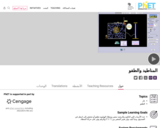
Experiment with a helium balloon, a hot air balloon, or a rigid sphere filled with different gases. Discover what makes some balloons float and others sink.
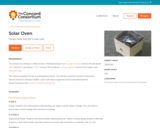
Elementary grade students investigate heat transfer in this activity to design and build a solar oven, then test its effectiveness using a temperature sensor. It blends the hands-on activity with digital graphing tools that allow kids to easily plot and share their data. Included in the package are illustrated procedures and extension activities. Note Requirements: This lesson requires a "VernierGo" temperature sensing device, available for ~ $40. This item is part of the Concord Consortium, a nonprofit research and development organization dedicated to transforming education through technology. The Consortium develops digital learning innovations for science, mathematics, and engineering.
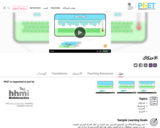
Learn how friction causes a material to heat up and melt. Rub two objects together and they heat up. When one reaches the melting temperature, particles break free as the material melts away. Arabic Language.
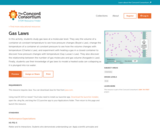
In this activity, students study gas laws at a molecular level. They vary the volume of a container at constant temperature to see how pressure changes (Boyle's Law), change the temperature of a container at constant pressure to see how the volume changes with temperature (Charles’s Law), and experiment with heating a gas in a closed container to discover how pressure changes with temperature (Gay Lussac's Law). They also discover the relationship between the number of gas molecules and gas volume (Avogadro's Law). Finally, students use their knowledge of gas laws to model a heated soda can collapsing as it is plunged into ice water.
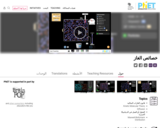
Pump gas molecules to a box and see what happens as you change the volume, add or remove heat, change gravity, and more. Measure the temperature and pressure, and discover how the properties of the gas vary in relation to each other.
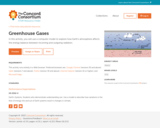
Explore how the Earth's atmosphere affects the energy balance between incoming and outgoing radiation. Using an interactive model, adjust realistic parameters such as how many clouds are present or how much carbon dioxide is in the air, and watch how these factors affect the global temperature.

Make your own miniature greenhouse and measure the light levels at different "times of day"--modeled by changing the angle of a lamp on the greenhouse--using a light sensor. Next, investigate the temperature in your greenhouse with and without a cover. Learn how a greenhouse works and how you can regulate the temperature in your model greenhouse.

Hands on Chemistry is a resource produced by Blue Ridge PBS in collaboration with Virtual Virginia and is designed for use in traditional, online, and blended high school Chemistry classrooms. In this video, Chemistry teacher Fred Mitchell demonstrates how both Charles's and Boyle's Laws express relationships between pressure, volume and temperature.
Keywords: combined gas laws, bolyes's law, charles's law, temperature, pressure, volume, vapor
Meets VA SOL CH.6
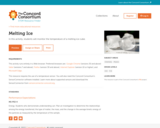
Monitor the temperature of a melting ice cube and use temperature probes to electronically plot the data on graphs. Investigate what temperature the ice is as it melts in addition to monitoring the temperature of liquid the ice is submerged in.

Video description: In this close-up video, Jacob Torres, Technical and Horticultural Scientist at NASA's Kennedy Space Center, shares how space biology brings together his love of engineering and growing plants. For his work, he builds technology that supports growing crops in ways that have never been done before. Video length: 2:35.NASA eClipsTM is a suite of online student-centered, standards-based resources that support instruction by increasing STEM literacy in formal and nonformal settings. These free digital and downloadable resources inform and engage students through NASA-inspired, real-world connections.NASA eClips Ask SME: Close-up with a NASA Subject Matter Expert videos are professionally developed to capture a glimpse of NASA SME's personal interests and career journeys. Each can be used to spark student interest and broaden their ideas of the STEM workforce. Additional videos in this series can be found by searching GoOpenVA using "NASA eClips Ask SME".

Video Description: Engineering design and technology development support scientific discovery. Learn about the roles engineers and scientists play when working together on NASA missions like the James Webb Space Telescope and how science and engineering take turns pushing each other to move exploration forward. Video Length: 4:16.NASA eClipsTM is a suite of online student-centered, standards-based resources that support instruction by increasing STEM literacy in formal and nonformal settings. These free digital and downloadable resources inform and engage students through NASA-inspired, real-world connections.NASA eClips Launchpad videos focus on NASA innovations and the technology that take us into the future. These segments support project-based and problem-based learning experiences in science, mathematics, and career and technical education classrooms.

Video Description: Each of us is made from star stuff. But how are stars formed? Take a closer look at the life cycles of stars and learn where stars come from, how they change, and what happens to stars when their lives come to an end. Find out about your connection to the cosmos. Video Length: 6:00.NASA eClipsTM is a suite of online student-centered, standards-based resources that support instruction by increasing STEM literacy in formal and nonformal settings. These free digital and downloadable resources inform and engage students through NASA-inspired, real-world connections.NASA eClips Launchpad videos focus on NASA innovations and the technology that take us into the future. These segments support project-based and problem-based learning experiences in science, mathematics, and career and technical education classrooms.

Video Description: Fire needs fuel, oxygen, and heat - no matter where the fire may be housed. Review fire safety rules while you learn more about research NASA is conducting to keep astronauts safe during space explorations. Video Length: 5:50 NASA eClipsTM is a suite of online student-centered, standards-based resources that support instruction by increasing STEM literacy in formal and nonformal settings. These free digital and downloadable resources inform and engage students through NASA-inspired, real-world connections.NASA eClips Our World videos (grades 3-5) help students understand the differences between science (the natural world) and engineering (the designed world). These video segments supplement elementary learning objectives not only in science, technology, engineering and mathematics, but also in reading, writing, visual and performing arts.

Video Description: No matter where plants grow, they have the same basic needs: water, nutrients, light, temperature, and atmosphere. No matter where humans may live, they need plants. Dr. Gioia Massa explains how NASA grows plants on the International Space Station in preparation for growing plants beyond Earth and, someday, on the Moon and Mars. Jacob Torres describes the hardware needed to provide open and closed systems for plant growth in space. This video shows how NASA scientists and engineers work together to learn more about ways plants live, grow, and adapt to live in varying environments. Video Length: 5:44.NASA eClips Our World videos (grades 3-5) help students understand the differences between science (the natural world) and engineering (the designed world). These video segments supplement elementary learning objectives not only in science, technology, engineering and mathematics, but also in reading, writing, visual and performing arts.

Video Description: Our Earth is a dynamic system with diverse subsystems that interact in complex ways.What are those subsystems and how do they interact?How are these subsystems and the global Earth system changing?What causes these changes?How does NASA monitor these changes?How can Earth system science provide societal benefit?Jessica Taylor, an atmospheric scientist at NASA Langley Research Center, and Dr. Steven Pawson, an Earth scientist from NASA Goddard Space Flight Center, help answer these questions and demonstrate how mathematical modeling helps scientists in their predictions of climate, weather, and natural hazards. Video Length: 5:02.NASA eClips Real World segments (grades 6-8) connect classroom mathematics to 21st Century careers and innovations. They are designed for students to develop an appreciation for mathematics through real-world problem solving.

Video Description: Balancing Earth's incoming and outgoing energy is like balancing an equation. When both are equal, Earth's energy is in balance. Learn more about how changes in this balance may impact Earth. Video Length: 2:56.NASA eClipsTM is a suite of online student-centered, standards-based resources that support instruction by increasing STEM literacy in formal and nonformal settings. These free digital and downloadable resources inform and engage students through NASA-inspired, real-world connections.NASA eClips Real World segments (grades 6-8) connect classroom mathematics to 21st Century careers and innovations. They are designed for students to develop an appreciation for mathematics through real-world problem solving.

Video Description: Earth's energy balance is very delicate. Small changes may have a big impact. How might changes in Earth's land and atmosphere impact this delicate balance? How might this knowledge be used to help us take better care of Earth? Video Length: 2:31.NASA eClipsTM is a suite of online student-centered, standards-based resources that support instruction by increasing STEM literacy in formal and nonformal settings. These free digital and downloadable resources inform and engage students through NASA-inspired, real-world connections.NASA eClips Real World segments (grades 6-8) connect classroom mathematics to 21st Century careers and innovations. They are designed for students to develop an appreciation for mathematics through real-world problem solving.